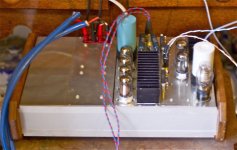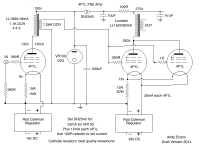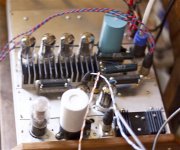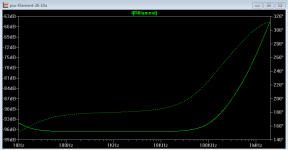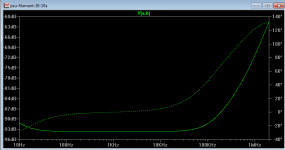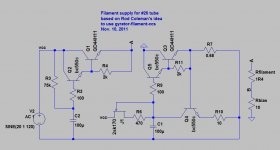DC voltage at G2 and A are different, due to Ia > Ig2. Datasheet reads 35mA to 6,5mA respectively. As for AC condition my understanding is: IL2pri is a function of Ug1 and Ua and, I guess mostly, current induced due by L1 winding.
Anyone correct me.
PS. Phase dots for the OPT is not shown. I assume primaries are in phase.
Anyone correct me.
PS. Phase dots for the OPT is not shown. I assume primaries are in phase.
Last edited:
PS. Phase dots for the OPT is not shown. I assume primaries are in phase.
Plate and G2 have the same phase in OPT.
Update on my 4P1L PSE. Here's a couple of pictures. The PSU and filament supplies are in separate chassis. I've been using this now for over a year, and no desire to use anything else. I've never been so happy with an amp build. I can't think of a better design for this power output - slightly more than a 2a3 SET. I attribute a lot of the success to using both stages in filament bias - no coupling caps and no cathode bypasses. Cathode resistors are 15 ohms for each stage. You can see the heatsinks and large wirewound cathode resistors which you need for filament bias.
What I have upgraded is the transformers. The interstage was Hammond 126C which is good, but the LL1660/18mA is better. The OPT was Audio Note Trans-152, then the cheapest O-netics, and now the Lundahl LL1620/80mA which is the best. I'm interested in upgrading the OPTs. Maybe Hashimoto H203S which is rated 7 watts. Or whatever. But the Lundahl is dynamic, detailed and has good bass, so pretty happy overall.
I urge anyone with time to spare to build this - it's better than all the 300b and 2a3 amps I ever built. And no more expensive 300b or 45 or 2a3 tubes - what a welcome relief!
What I have upgraded is the transformers. The interstage was Hammond 126C which is good, but the LL1660/18mA is better. The OPT was Audio Note Trans-152, then the cheapest O-netics, and now the Lundahl LL1620/80mA which is the best. I'm interested in upgrading the OPTs. Maybe Hashimoto H203S which is rated 7 watts. Or whatever. But the Lundahl is dynamic, detailed and has good bass, so pretty happy overall.
I urge anyone with time to spare to build this - it's better than all the 300b and 2a3 amps I ever built. And no more expensive 300b or 45 or 2a3 tubes - what a welcome relief!
Attachments
Last edited:
Andy,
It is such a coincidence, but I just finished my "Shiny Eyes" PSE all 4P1L amp on the 12th. I am doing some final measurements and will post soon. I can't agree more with you about the sound of this amp. I use Lundahl too and very happy.
Congratulations for such a great accomplishement.

Best,
Radu
It is such a coincidence, but I just finished my "Shiny Eyes" PSE all 4P1L amp on the 12th. I am doing some final measurements and will post soon. I can't agree more with you about the sound of this amp. I use Lundahl too and very happy.
Congratulations for such a great accomplishement.
Best,
Radu
Andy,
It is such a coincidence, but I just finished my "Shiny Eyes" PSE all 4P1L amp on the 12th. I am doing some final measurements and will post soon. I can't agree more with you about the sound of this amp. I use Lundahl too and very happy.
Congratulations for such a great accomplishement.
Best,
Radu
Great! I'm very interested in your amp. Can you post a schematic when you're ready? Are you using filament bias for both stages? Which Lundahls?
Andy,
That was very convincing. I will definitely build one!
I have good feedback from users of the amorphous core Lundahls, they are quite expensive but it may be worth it.
I find the amorphous type not as good as the standard type for SE. I have tried with the LL1627 and the stardard type is miles better!!
Inductance is quite lower for the amorphous type and distortion is notably higher already from 200-250 Hz getting worse and worse at lower frequency. This has a clear bad effect on the overall sound, not just the bass. The amorphous might work better in a bi-amp system where doesn't have to reproduce the bass.
Andy,
That was very convincing. I will definitely build one!
I have good feedback from users of the amorphous core Lundahls, they are quite expensive but it may be worth it.
The tubes are cheap - you risk nothing by building one. You'll need filament boards from Rod Coleman, but they are very good value as well. Don't economise on the cathode resistors, like aluminium clad or ceramic. You need the best wirewounds like the porcelain ones in the photo or the Dale surplus stock ones in the input. Heatsink sizes as shown.
Minor edit to the schematic - grid stoppers are all 390 ohms (not 1K). No particular reason for the value - just what I had. You can experiment. With 2v in from my DAC this drives simple full-range speakers like the Mark Audio Alpair 10s I use. That's in a small/medium room. No need for a preamp. The mu of the 4P1L is around 11 - makes a difference in the output stage over the usual suspects.
Don't be tempted by anything other than filament bias in both stages - it's crucial to the sound quality! If you can use a choke in the supply so much the better. Hammond 159ZA for one 4P1L and 159ZC for a pair in parallel. Your chassis needs to be solid - particularly the top plate - since the 4P1L can be microphonic. Not an issue in the output and never bothered me in the input, but I do have a very solid chassis. It helps to run the input tubes at 1.9v (parallel filaments) and you can also wrap layers of teflon plumbers tape around the bottle and finish with some insulating tape to hold it on. I've done that and it works fine.
Last edited:
You'll need filament boards from Rod Coleman,
Maybe some day we'll get some actual DIY discussion on filament regulators again.... for the past year or so the Y aspect of DIY has vanished from filament regulators.
Maybe some day we'll get some actual DIY discussion on filament regulators again.... for the past year or so the I.Y. aspect of DIY has vanished from filament regulators.
I don't know - Rod's regulators are so good and so relatively cheap he's set the standard really. I do use chokes in the input section, though. If you use choke input there's quite a field around the choke so it should really be in another box where you can keep it away from circuitry.
Maybe some day we'll get some actual DIY discussion on filament regulators again.... for the past year or so the Y aspect of DIY has vanished from filament regulators.
That day belongs to 2011
P.S. Rod's initial circuit that I started with can be found here http://www.diyaudio.com/forums/tubes-valves/38248-new-dht-heater-7.html#post2024952
Attachments
Its a weakpoint from amorphous and nanocristalinematerials. Most people think that these "high tech" materials are always better but its not. Also copper loss is higher then standard silicium iron.
I find the amorphous type not as good as the standard type for SE. I have tried with the LL1627 and the stardard type is miles better!!
Inductance is quite lower for the amorphous type and distortion is notably higher already from 200-250 Hz getting worse and worse at lower frequency. This has a clear bad effect on the overall sound, not just the bass. The amorphous might work better in a bi-amp system where doesn't have to reproduce the bass.
Update on my 4P1L PSE. Here's a couple of pictures. The PSU and filament supplies are in separate chassis. I've been using this now for over a year, and no desire to use anything else. I've never been so happy with an amp build. I can't think of a better design for this power output - slightly more than a 2a3 SET. I attribute a lot of the success to using both stages in filament bias - no coupling caps and no cathode bypasses. Cathode resistors are 15 ohms for each stage. You can see the heatsinks and large wirewound cathode resistors which you need for filament bias.
What I have upgraded is the transformers. The interstage was Hammond 126C which is good, but the LL1660/18mA is better. The OPT was Audio Note Trans-152, then the cheapest O-netics, and now the Lundahl LL1620/80mA which is the best. I'm interested in upgrading the OPTs. Maybe Hashimoto H203S which is rated 7 watts. Or whatever. But the Lundahl is dynamic, detailed and has good bass, so pretty happy overall.
I urge anyone with time to spare to build this - it's better than all the 300b and 2a3 amps I ever built. And no more expensive 300b or 45 or 2a3 tubes - what a welcome relief!
I would suggest Pieter's nanocrystaline core transformers over Hashimoto. IMO the former are very high resolution.
A little bit out topic...
I'm new to DH Triode/Pentode and want to build 4P1L Parallel SE amp , 2 channel....question is do I really need two separate Power trafo winding for the DH filament for stereo?
I have SMPS psu for the filament 5v, 10amps , do I need two for stereo....I thought 1 is sufficient since it has lots of current but someone says no....Why?
I'm new to DH Triode/Pentode and want to build 4P1L Parallel SE amp , 2 channel....question is do I really need two separate Power trafo winding for the DH filament for stereo?
I have SMPS psu for the filament 5v, 10amps , do I need two for stereo....I thought 1 is sufficient since it has lots of current but someone says no....Why?
A little bit out topic...
I'm new to DH Triode/Pentode and want to build 4P1L Parallel SE amp , 2 channel....question is do I really need two separate Power trafo winding for the DH filament for stereo?
I have SMPS psu for the filament 5v, 10amps , do I need two for stereo....I thought 1 is sufficient since it has lots of current but someone says no....Why?
yes....
why? because DHT's have filaments that serve as cathodes also,
unless you inject negative voltage to each grids,
a common filament supply is impossible...
- Home
- Amplifiers
- Tubes / Valves
- One more 4P1L SE
